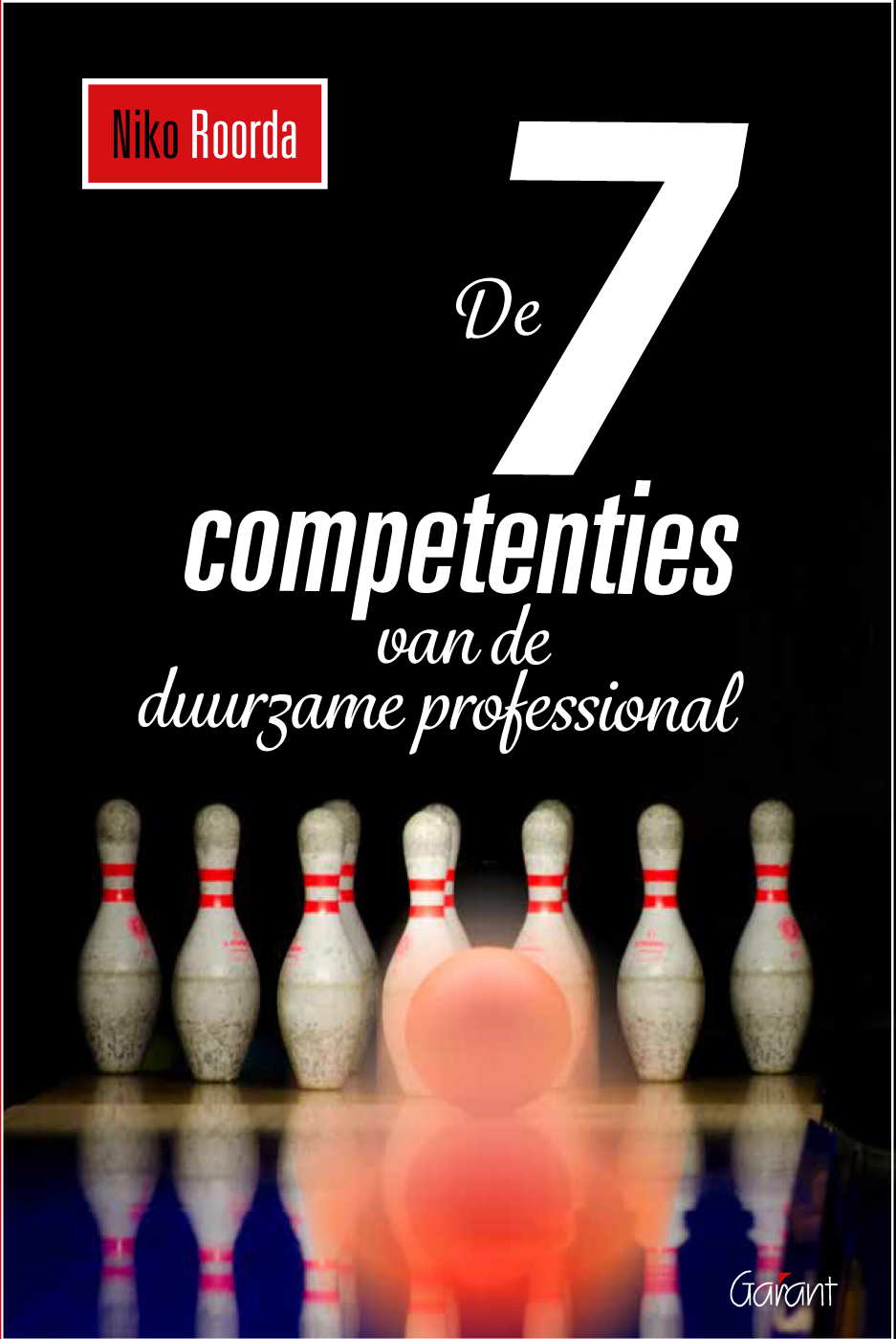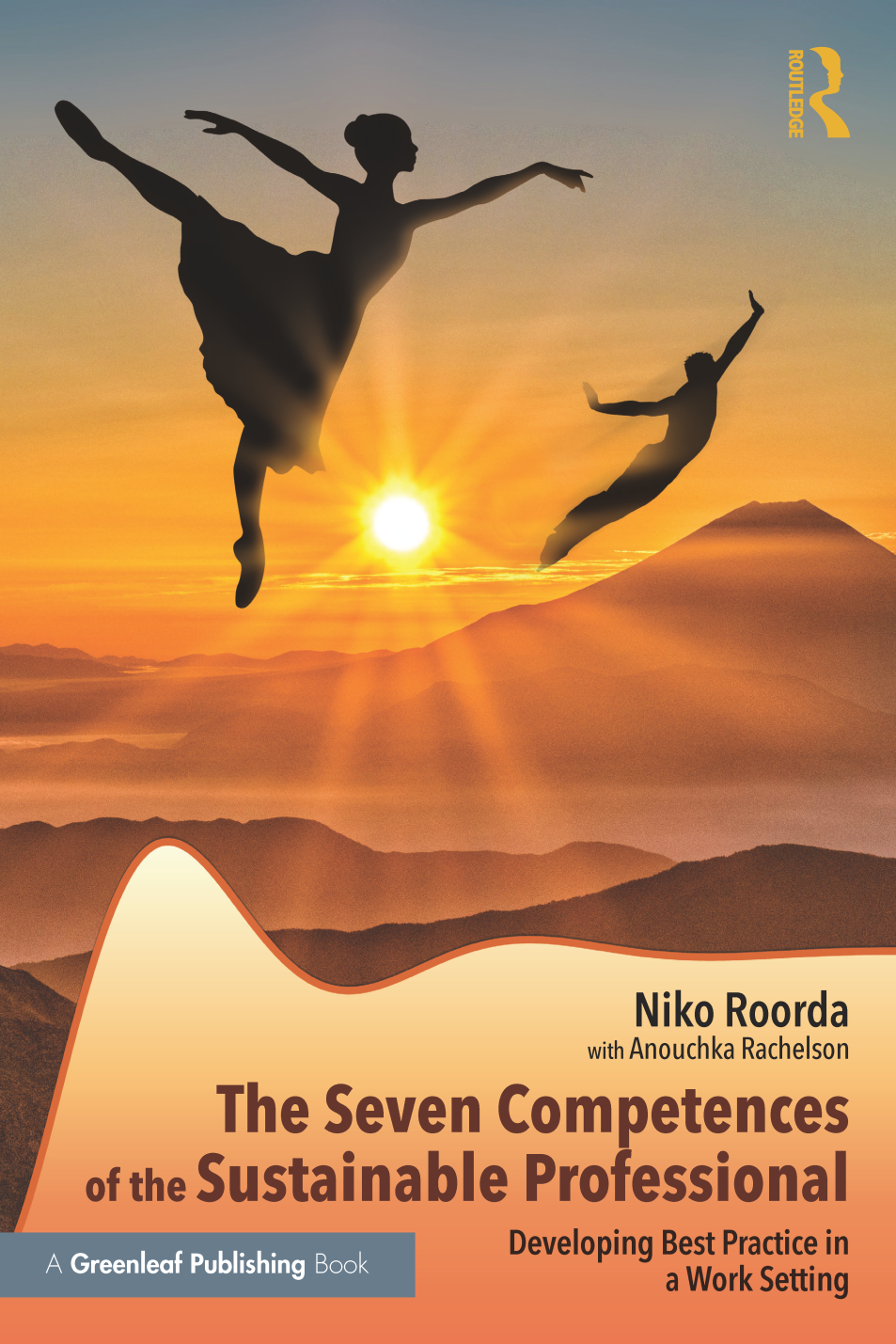The International 7 Competences Book Project An invitation to co-create ... |
RESFIA+D, also called The 'Seven SD Competences' (SD = Sustainable Development), is a model that defines a set of sustainability competences. Using RESFIA+D, it is possible:
- For higher education: to assess the current SD aspects of the set of educational outcomes of BSc and MSc programs, such as the academic profile or the competences of the graduate; to (re)define or improve them; and next, to (re)develop the curriculum, based upon the improved definition of the study outcomes.
- For individual professionals and students: to self-assess their personal competences related to SD; to invite others to assess them (360° feedback); and to use the results for their personal development plan.
- For companies and other organizations: as a tool for HRM and HRD (Human Resource Development).
The details of RESFIA+D are described here. A publication describing the theoretical backgrounds can be downloaded.
Several books are published around RESFIA+D: a Dutch and an American edition, as the images show: click on their covers to find a detailed description of them. The books were written because, while applying RESFIA+D, participants repeatedly expressed the wish to have a series of practical examples. "How do you do it, those sustainability competences? In your actual work?" was the question Niko Roorda regularly received as a consultant and trainer.
The next book? |
This question was the start of an international project, aiming at creating books about the RESFIA+D competences, offering real-life stories from professionals, in various languages.
The first book, published in Dutch in 2015, was written by Niko Roorda. The second book, published in 2018 in English, was adapted by co-author Anouchka Rachelson, aiming mainly at US and Canadian readers.
The same approach will be used for the next editions: starting from the Dutch book (which is available in an English translation), one or more co-authors are invited to adapt the book for their own language, country, or region. What this means, is described below.
Co-author: If you are interested in becoming a co-author, perhaps together with your students, your colleagues or your institution? Please contact Niko Roorda.
Erasmus+: Or perhaps you feel that your institution (within a university or college) is the right party to initiate an Erasmus+ project or something similar, aiming at the parallel creation of a series of books in a range of languages? Again: please contact Niko Roorda.
The RESFIA+D model, and some other theoretical backgrounds (e.g. on SD), are described briefly in the book, mainly in the odd-numbered chapters (1, 3, 5, etc.).
The even-numbered chapters contain ‘stories’ by professionals. Each of these chapters is dedicated to one of the 'generic' competences ('R-E-S-F-I-A'), i.e. those that are not specific to certain branches or professions. In the Dutch edition, the stories are all told by Dutch or Belgian professionals; in the USA edition they are all Americans in the USA or Canada. The stories are based on real persons, and are created based on interviews with those persons or written by them, followed by the necessary editing by the (co-)author(s).
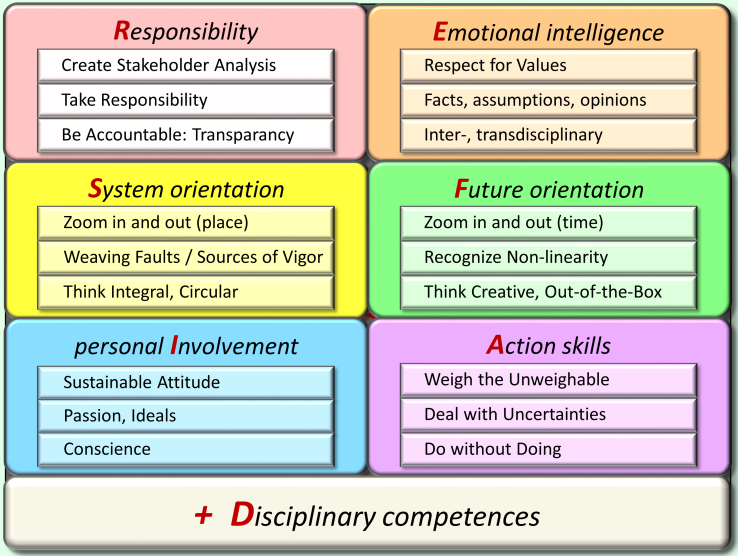
RESFIA+D defines six generic SD competences ('R-E-S-F-I-A') and one group of disciplinary ones ('D').
Each of the six generic competences is subdivided into three concrete achievements.
All stories are supported by brief introductions and explanations. These introductions and explanations, together with the theoretical backgrounds in the odd-numbered chapters, are the ‘framework’ of the book.
A new edition is created by preserving the framework and substituting the stories with stories situated in the targeted country/countries or language area.
Finding and writing/editing the substituting stories is the task for the co-author(s). All substitutions will be proposed to the author and discussed together until both the author and the co-author(s) are happy with the result. So, the new edition will be a co-creation.
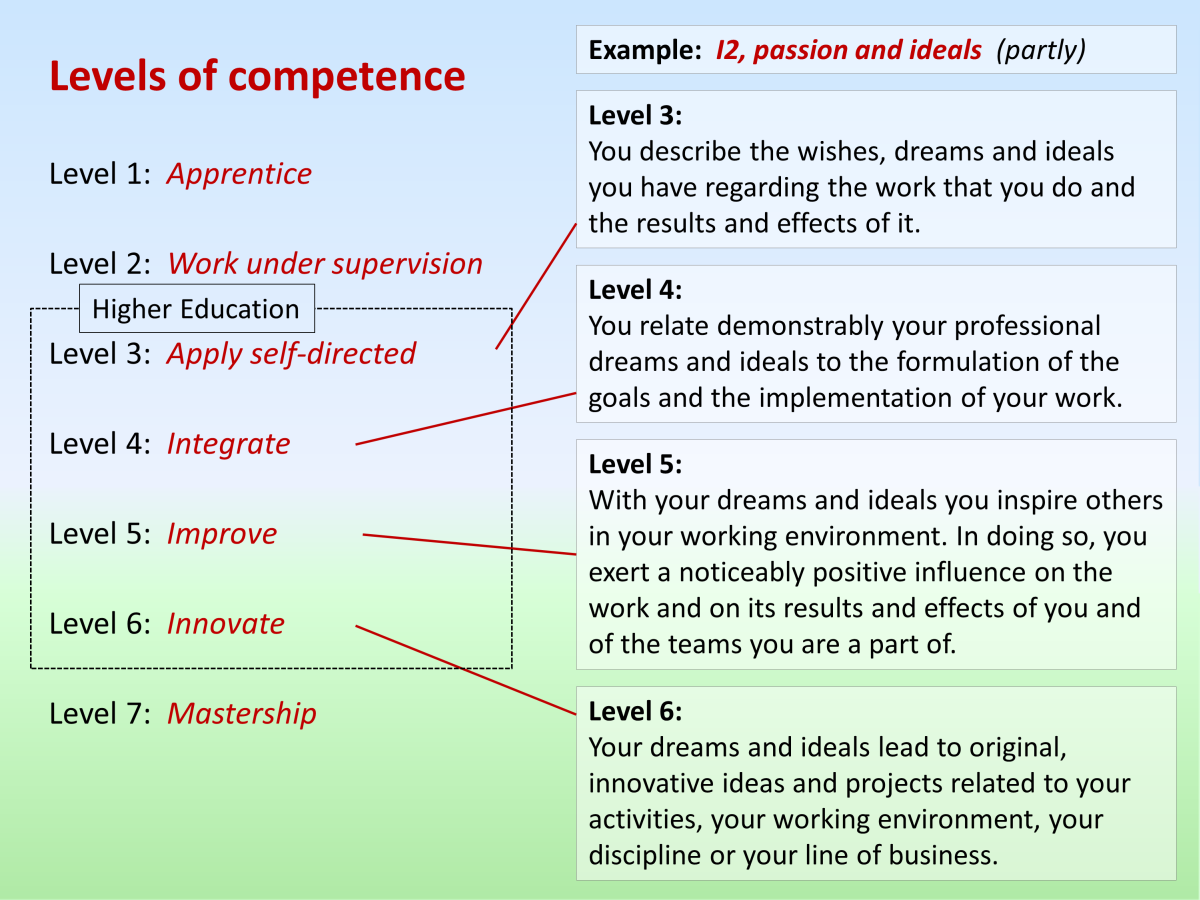
RESFIA+D applies seven competence levels.
Levels 3 till 6 are suitable final competences for BSc or MSc programs:
For each competence, subdivided into three achievements, these levels are described in detail.
The image show an example: achievement I2, a part of competence I: personal Involvement.
(The level descriptions are slightly simplified.)
A special case is chapter 11. This chapter deals with the so-called ‘disciplinary competences’ ('D'), illustrated by a series of stories. Although this chapter is odd-numbered, the stories don’t belong to the framework and are to be replaced.
The author is able to read texts in English, German and French, so co-author(s) for those languages will be allowed to submit the substitutions in their own language. For other languages, the co-author(s) will have to produce substituting stories both in their own language (for the book) and in English (for the author).
Other tasks of the co-author(s) may be related to the preparation of the publication of the book:
- translating the framework into their own language, and
- finding a publishing company that is willing to publish the new edition.
However, other ways may be found for these tasks; this will always be a matter of finding the best way, in consensus between the author, the co-author(s), and the publishing company.
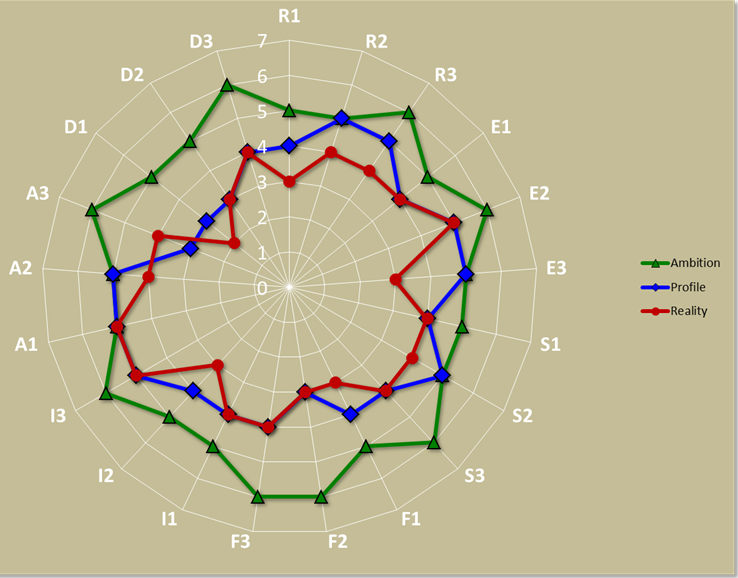
The image shows the result of an actual RESFIA+D assessment of a BSc program:
First, a set of disciplinary competences was defined (D1, D2, D3).
As a preparation, a group of lecturers, students, managers and external experts was formed.
Next, the Ambition was decided for each competence (i.e. the required competence levels).
Then, the actual Competence Profile was discovered, as described in the study guide.
Finally, Reality struck, as it was discovered which competence levels are actually realized within the curriculum.
The result: Reality < Profile < Ambition, proving that much work needed to be done.
The RESFIA+D model comes with a set of Excel spreadsheets (so far in Dutch and in English) that can be used as tools for the application of RESFIA+D: (1) for education (re)development (see image); (2) for individual professionals and their coaches; and (3) for HRM. These spreadsheets will also have to be translated into the newly targeted language(s), but not necessarily by the co-author(s): see above. Preferably, the spreadsheets will be made available through the website of the publishing company (or some other website.)
If an Erasmus+ project is proposed, there may be some more interesting tasks, such as:
- Apply RESFIA+D as an assessment and policy instrument in companies and other organizations in the participating countries;
- Let the method be applied by individual professionals;
- Apply RESFIA+D to improve study programs (BSc, MSc) in the participating universities and colleges, starting from their graduation targets;
- Let the method be applied by students during their internships and graduation projects;
- Perform scientific research with respect to RESFIA+D and other descriptions of competences related to SD, e.g. the 21st Century Skills, also in relation to the SDGs;
- Build capacity: train and certify assessors, who then will be able to continu the application of RESFIA+D after the project is finished.
Some Guiding Lines for co-authors
A complete set of guiding lines for co-authors is avaliable and will be sent on request. Here are a few of them:
- Although most of the contributing professionals should be relatively unknown (so the reader will easily identify with them), it is desirable that ca. 5 persons have a nation-wide name and reputation, i.e. are 'famous' (so they will set an inspiring example and role model – and it may help marketing the book).
- Contributing professionals should together be representative of many different disciplines and many different branches. Such as: profit and non-profit; formal and less formal companies and organizations; large (even multinational) and small (even 1-person) organizations; paid and voluntary jobs.
- When someone works as a volunteer in a professional context, acting in the way a paid professional would do, this person counts as a professional: the mere fact that they don't get paid for the job does not exclude the case (but it should be mentioned in the case).
- Contributing professionals should together be representative of many different levels of work and education, varying perhaps from, say, janitors to CEOs or from clerks to state secretaries.
- Contributing professionals should together be fairly representative of the entire geographical scope of the edition, i.e. living and working in all parts of the country (countries).
- Contributing professionals should together be fairly representative of all (adult) ages, ethnicities and genders.
- Whenever possible, both the name of the professional and the name of the organization they work for should be mentioned, in order to make the case more realistic and ‘alive’. Only if there are severe reasons for anonymity (e.g. protection of privacy, risk of legal consequences, risk of violence, etc.), the name(s) can be left out or replaced. This should be an exception, and so the need to leave out names might be a reason against using the case.
Some legal and financial aspects:
- Any revenues of the edition will be divided between the author and the co-author(s) in a ratio of 60% for the author and 40% for the co-author(s together), unless, due to special reasons, it is agreed between them on beforehand to divide the revenues in a different way. This includes all royalties, public lending rights, and any other direct revenues of the book.
- On the other hand: fees for activities that are based on the book, such as presentations, assessments, training courses or workshops, performed by the author or by the co-author(s), are not to be divided between them all: they are the exclusive fees for those who perform the activities.


